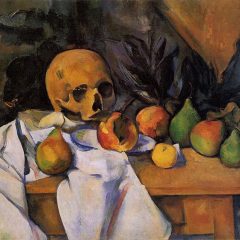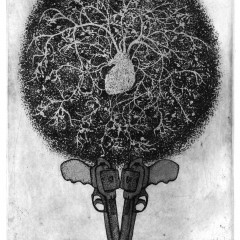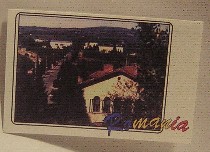 An offbeat group show at Photo West Gallery is worth the time of a visit. The show is filled with more than 35 pieces of art based on old propaganda photos set out for disposal outside a Romanian consulate and museum in New York. Romanian artist Irina Hasnas Pascal, on finding the photos, snatched up about 40 of them and got this idea to invite artists to make work inspired by the photographs (image, a travel postcard by Tara O’Brien, inscribed “Romania,” using one of the propaganda photographs of a town sanitized of its inhabitants to create an image of small-town perfection; come on down).
An offbeat group show at Photo West Gallery is worth the time of a visit. The show is filled with more than 35 pieces of art based on old propaganda photos set out for disposal outside a Romanian consulate and museum in New York. Romanian artist Irina Hasnas Pascal, on finding the photos, snatched up about 40 of them and got this idea to invite artists to make work inspired by the photographs (image, a travel postcard by Tara O’Brien, inscribed “Romania,” using one of the propaganda photographs of a town sanitized of its inhabitants to create an image of small-town perfection; come on down).Hasnas Pascal is here in Philadelphia, studying at the University of the Arts Museum Studies graduate program on a Fullbright Scholarship. The show, it turns out, was a lesson in curating all its own.
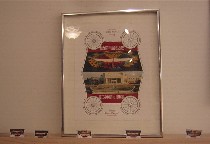 She confessed in an email that she was taken aback by the art she got back, much of it quite different from what she expected. At some point, she said, she realized she had lost control of the exhibit, which turned out to be as much an exhibit on American values as on Romanian propaganda (image, Phil Schulman’s conversion of a photo of a palace and gardens into a sort of Conestoga wagon cut-out, small multiple versions arranged on the picture rail; the words read, “Moscow or Bust”. I wasn’t sure if these were giveaways or not, but I snatched one for my collection of art ephemera).
She confessed in an email that she was taken aback by the art she got back, much of it quite different from what she expected. At some point, she said, she realized she had lost control of the exhibit, which turned out to be as much an exhibit on American values as on Romanian propaganda (image, Phil Schulman’s conversion of a photo of a palace and gardens into a sort of Conestoga wagon cut-out, small multiple versions arranged on the picture rail; the words read, “Moscow or Bust”. I wasn’t sure if these were giveaways or not, but I snatched one for my collection of art ephemera).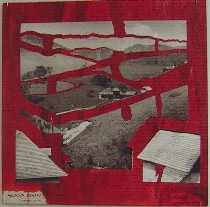 Hasnas Pascal grew up in Romania under its most repressive, most controlling regime (in our conversation, never once did she name former dictator Nicolae Ceausescu by name). So her own feeling of the need to control the show upset her. As the works of art came in, she threw final control aside and decided to put everything up and to ignore issues of quality in the hanging. A week after the opening, while she was talking to me in the gallery, a tardy piece of art arrived for inclusion. But for all the frustrations, the show intrigued me (image, Eriko Takahashi’s beautiful, torn and reworked landscape; what were they thinking? a landscape as propaganda is a funny sort of concept).
Hasnas Pascal grew up in Romania under its most repressive, most controlling regime (in our conversation, never once did she name former dictator Nicolae Ceausescu by name). So her own feeling of the need to control the show upset her. As the works of art came in, she threw final control aside and decided to put everything up and to ignore issues of quality in the hanging. A week after the opening, while she was talking to me in the gallery, a tardy piece of art arrived for inclusion. But for all the frustrations, the show intrigued me (image, Eriko Takahashi’s beautiful, torn and reworked landscape; what were they thinking? a landscape as propaganda is a funny sort of concept).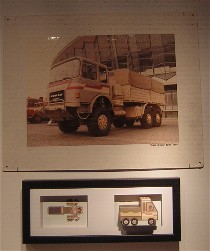 I was interested in the multiplicity of ideas, the very real issues of propaganda and lies, and the multi-cultural points of view taking us beyond our own little corner of the world. Among the contributors are several people born in Romania, immigrants from elsewhere, and a mix of local artists, familiar and unfamiliar to me–for a list of contributors plus some Romanian music, go here (image, “Roman Diesel” motor lorry, transformed by Barbara Zuckerman into a paper version; this piece went in so many directions–industrial drawing, the suggestion of mass production and commerce, the hint of national pride, the macho vehicle turned into a beautiful but flimsy paper toy that belies the photograph’s image, etc. etc).
I was interested in the multiplicity of ideas, the very real issues of propaganda and lies, and the multi-cultural points of view taking us beyond our own little corner of the world. Among the contributors are several people born in Romania, immigrants from elsewhere, and a mix of local artists, familiar and unfamiliar to me–for a list of contributors plus some Romanian music, go here (image, “Roman Diesel” motor lorry, transformed by Barbara Zuckerman into a paper version; this piece went in so many directions–industrial drawing, the suggestion of mass production and commerce, the hint of national pride, the macho vehicle turned into a beautiful but flimsy paper toy that belies the photograph’s image, etc. etc).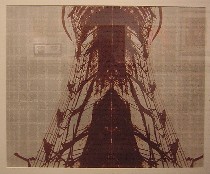 So many of the photos artists chose to work with were photos showing productivity, infrastructure and commerce, some of the things that were completely inadequate in Ceausescu’s Romania. This image is Lucia Farias’ print of some sort of infrastructure tower with workers climbing up the sides. Farias has doubled the image of the original half-a-tower of the photograph, thereby doubling the lie on top of a grid of words in what looks like a mix of English and Spanish. I’m not sure what they words say, but the suggestion of imposed control and order and personal frustration come through loud and clear.
So many of the photos artists chose to work with were photos showing productivity, infrastructure and commerce, some of the things that were completely inadequate in Ceausescu’s Romania. This image is Lucia Farias’ print of some sort of infrastructure tower with workers climbing up the sides. Farias has doubled the image of the original half-a-tower of the photograph, thereby doubling the lie on top of a grid of words in what looks like a mix of English and Spanish. I’m not sure what they words say, but the suggestion of imposed control and order and personal frustration come through loud and clear.
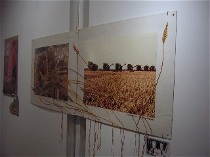 Simona Josan, too, chose photographs suggesting a functioning economy, one a field of wheat and one a huge housing block. Josan imposed her own embroidered wheat images, thereby sewing together the city and the country. In the background, a lineup of wheat harvesters against the sky look more like a lineup of military tanks. Josan, who comes from Romania, also left embroidery thread hanging at the bottom like exposed roots.
Simona Josan, too, chose photographs suggesting a functioning economy, one a field of wheat and one a huge housing block. Josan imposed her own embroidered wheat images, thereby sewing together the city and the country. In the background, a lineup of wheat harvesters against the sky look more like a lineup of military tanks. Josan, who comes from Romania, also left embroidery thread hanging at the bottom like exposed roots.
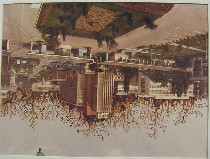 Josan’s sister Alina, who we have written about previously in artblog, created a triptych. In one of the three images, she inverted a large modern building and painted roots growing from the roof into the sky, reflecting and inverting the thicket of aerials poking up into the sky from another, similar building. In still another, the sky becomes the ocean in front of the inverted building (image, detail of one part of the triptych).
Josan’s sister Alina, who we have written about previously in artblog, created a triptych. In one of the three images, she inverted a large modern building and painted roots growing from the roof into the sky, reflecting and inverting the thicket of aerials poking up into the sky from another, similar building. In still another, the sky becomes the ocean in front of the inverted building (image, detail of one part of the triptych).
Both Josans’ works are personal, poetic and beautifully made. They are as much about displacement and yearning as they are about propaganda.
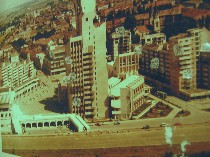 Aki Shigemori chose a photograph of another ultra-large modern building, which was labeled as new housing. The artist emended the picture with delicate, tiny drawings of people going about daily tasks like caring for babies, eating and such. The people look fragile, pinned atop the photo, hanging in the air, as compared to the monumental power of the state, its buildings and its propaganda. The suggestion here is that private life goes on inside, but that privacy is circumscribed and even crushed by state control.
Aki Shigemori chose a photograph of another ultra-large modern building, which was labeled as new housing. The artist emended the picture with delicate, tiny drawings of people going about daily tasks like caring for babies, eating and such. The people look fragile, pinned atop the photo, hanging in the air, as compared to the monumental power of the state, its buildings and its propaganda. The suggestion here is that private life goes on inside, but that privacy is circumscribed and even crushed by state control.
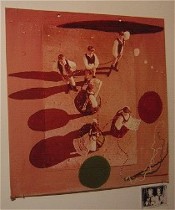 The shadowy state and its power also transform shadows into ominous presences in a couple of pieces by Ana Uribe. (Uribe uses paint to enlarge the shadows of Romanian folk dancers in this image).
The shadowy state and its power also transform shadows into ominous presences in a couple of pieces by Ana Uribe. (Uribe uses paint to enlarge the shadows of Romanian folk dancers in this image).
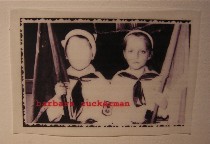 But the largest shadow is cast by Hasnas Paschal herself, whose toss-off labels identify the artist of each piece. The labels are of an old photo of herself and a friend as schoolgirls in uniform. The friend’s face is cut out of the picture, speaking of loss and the past and its ghosts and also speaking of an empty slot waiting to be filled with new faces and a new Romania. The show remains up until Dec. 2.
But the largest shadow is cast by Hasnas Paschal herself, whose toss-off labels identify the artist of each piece. The labels are of an old photo of herself and a friend as schoolgirls in uniform. The friend’s face is cut out of the picture, speaking of loss and the past and its ghosts and also speaking of an empty slot waiting to be filled with new faces and a new Romania. The show remains up until Dec. 2.




